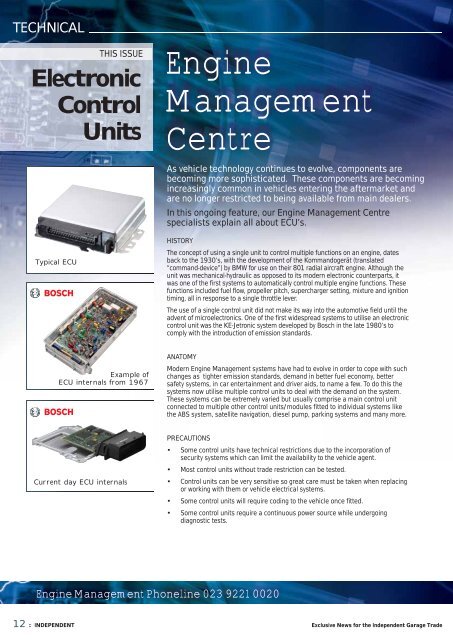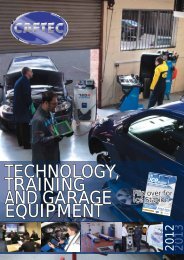issue 63 - Camberley Auto Factors Ltd
issue 63 - Camberley Auto Factors Ltd
issue 63 - Camberley Auto Factors Ltd
Create successful ePaper yourself
Turn your PDF publications into a flip-book with our unique Google optimized e-Paper software.
TECHNICAL<br />
THIS ISSUE<br />
Electronic<br />
Control<br />
Units<br />
Typical ECU<br />
Example of<br />
ECU internals from 1967<br />
Current day ECU internals<br />
Engine<br />
Management<br />
Centre<br />
Engine Management Phoneline 023 9221 0020<br />
12 :: INDEPENDENT<br />
As vehicle technology continues to evolve, components are<br />
becoming more sophisticated. These components are becoming<br />
increasingly common in vehicles entering the aftermarket and<br />
are no longer restricted to being available from main dealers.<br />
In this ongoing feature, our Engine Management Centre<br />
specialists explain all about ECU’s.<br />
HISTORY<br />
The concept of using a single unit to control multiple functions on an engine, dates<br />
back to the 1930’s, with the development of the Kommandogerät (translated<br />
“command-device”) by BMW for use on their 801 radial aircraft engine. Although the<br />
unit was mechanical-hydraulic as opposed to its modern electronic counterparts, it<br />
was one of the first systems to automatically control multiple engine functions. These<br />
functions included fuel flow, propeller pitch, supercharger setting, mixture and ignition<br />
timing, all in response to a single throttle lever.<br />
The use of a single control unit did not make its way into the automotive field until the<br />
advent of microelectronics. One of the first widespread systems to utilise an electronic<br />
control unit was the KE-Jetronic system developed by Bosch in the late 1980’s to<br />
comply with the introduction of emission standards.<br />
ANATOMY<br />
Modern Engine Management systems have had to evolve in order to cope with such<br />
changes as tighter emission standards, demand in better fuel economy, better<br />
safety systems, in car entertainment and driver aids, to name a few. To do this the<br />
systems now utilise multiple control units to deal with the demand on the system.<br />
These systems can be extremely varied but usually comprise a main control unit<br />
connected to multiple other control units/modules fitted to individual systems like<br />
the ABS system, satellite navigation, diesel pump, parking systems and many more.<br />
PRECAUTIONS<br />
• Some control units have technical restrictions due to the incorporation of<br />
security systems which can limit the availability to the vehicle agent.<br />
• Most control units without trade restriction can be tested.<br />
• Control units can be very sensitive so great care must be taken when replacing<br />
or working with them or vehicle electrical systems.<br />
• Some control units will require coding to the vehicle once fitted.<br />
• Some control units require a continuous power source while undergoing<br />
diagnostic tests.<br />
Exclusive News for the Independent Garage Trade




